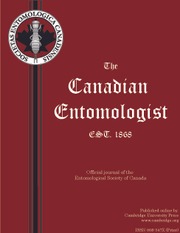Article contents
Notes on Parasites of the Wheat Stem Sawfly, Cephus pygmaeus (L.) (Hymenoptera: Cephidae) from Continental Europe
Published online by Cambridge University Press: 31 May 2012
Extract
Larvae of the European wheat stem sawfly, Cephus pygmaeus (L.), in hibernacula in wheat stubs were obtained from Russia and Sweden in the fall of 1959 by the Entomology Research Institute for Biological Control in a renewed attempt to find parasites for use against the wheat stem sawfly, Cephus cinctus Nort., in Western Canada. An earlier attempt to colonize the parasite Collyria calcitrator (Grav.) from England failed in spite of early promise of success (Smith, unpublished reports). Though Collyria spp. were expected to predominate in the Continental collections, their different geographical origins opened the prospect of finding different species or strains better suited to Canadian conditions. There was also the possibility of discovering additional parasites suitable for trials in Canada.
Information
- Type
- Articles
- Information
- Copyright
- Copyright © Entomological Society of Canada 1961
References
- 5
- Cited by

